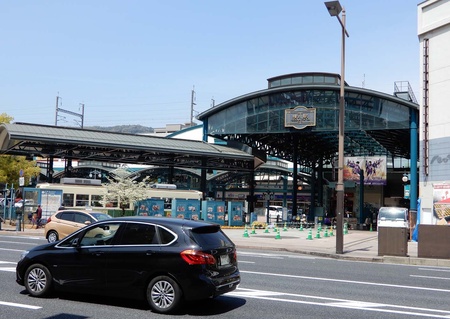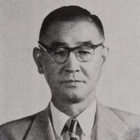Visiting the former address
Now that I have been able to summarize the life of Kato Shinichi from the profile article, which can be considered a self-introduction in "A Centennial History of Japanese Americans in the United States," and his obituary in the Chugoku Shimbun newspaper on February 10, 1982, I have decided to once again look for his relatives and people who knew him, as he was born in Hiroshima and ended up spending his entire life in his hometown.
Kato's only son, who was born in the United States, returned to the United States after graduating from high school in Japan, so it seemed unlikely that he had any direct relatives in Japan. So, I decided to first visit the address listed in the obituary, where I believe Kato had been living. This was in April 2019.
Kato's former home was located just over two kilometers northwest of the center of Hiroshima city, just a few minutes' walk from Yokokawa Station on the JR Sanyo Main Line and very close to Yokokawa 1-Chome Station on the Hiroshima Electric Railway tram line.

I was staying in the city center, so I took the streetcar to Yokokawa 1-chome, confirmed the location, and walked around the area a bit. There was a park and it was a mix of businesses and houses.
The address on the notice had changed slightly since then, but the place I thought was probably this one was now a parking lot. I thought I'd try asking around at a nearby house, asking if anyone knew a Mr. Kato who used to live around here, so I rang the doorbell of a house, but there was no answer. I then asked at a warehouse-like business, but was told I should ask at the police box.
Thinking that there was no way they would know anything at the police box in the city, let alone in the countryside, I went into a small general store that caught my eye and asked a young woman, who kindly said that the owner of the store might know, and called the owner over. After a while, an elderly woman appeared and said, "I don't know the details, but I know Kato-san," and remembered the past. From the friendly tone of her voice, it seemed that she had a good impression of Kato Shinichi.
The grave in the family temple has already been moved.
However, they didn't seem to know where Kato's relatives were. So I left the area and headed to Enryuji Temple, where the obituary said "the funeral was held." I later learned that the western part of Hiroshima Prefecture was a place where the Jodo Shinshu sect flourished, led by followers called "Aki-monto," and that the area known as "Teramachi" was home to many Jodo Shinshu temples, and Enryuji Temple was one of them.
When I called out to her from the entrance on the side of the concrete building that leads to the impressive main hall, a middle-aged woman came out. After apologizing for my sudden visit, I explained the situation and asked about Kato Shinichi's grave and its caretaker. She kindly put me through to a woman who seemed to be the "previous wife" of the current head priest. The elderly woman who came out to the entrance said,
"Mr. Kato did have a grave, but there was no one nearby to take care of it, so a relative took it in," he told me sadly.
Apparently the relative's name was Yoshida, and when I told him he probably knew the contact details, he went back inside, looked it up, and called. However, it seemed he had trouble getting in touch. I felt like I was so close, but I left the temple feeling grateful for the kind hospitality he showed me despite my sudden visit.
On the way there, I went to the city library to look for books about Hiroshima people who, like Kato, had made the journey to California, but I didn't find much.The next day, I decided to make inquiries again in the area around Kato's house.
A warm and popular person
Hiroshima city has trams, so it is convenient for short distance travel. However, as the city is not hilly, it seems that bicycles are more convenient for visiting several points, even when it is not raining, as can be seen from the number of bicycles going around. Luckily, the city has a rental system for electric bicycles, with bicycles pooled in various locations, allowing you to rent one from a convenient location and return it wherever you like. It also seems convenient for traveling around for sightseeing.
After learning how it worked, I decided to give it a try. First, I pedaled towards Nishi-Hiroshima Station, where Kato had been at the time of the atomic bombing, and after driving around for a while, I arrived at the former location of Kato's house, just like the day before. While asking around the neighbors, I met two women who had connections with Kato.
One of them, whose mother had known Kato when he was alive, was unable to meet him that day. The other was Mr. K, whose mother said that Kato's eldest son, Kenneth (Nao), had been close to her brother when they were young and often came to visit Mr. K's house.
When she was young, Ms. K. reminisced about Kato, saying, "He was a gentle person. He was well-liked, and after the war, when the members of the Board of Education were elected, he was a candidate. My parents supported him, but I remember that he lost just short of victory." From what Ms. K. said, Kato seemed to be well-liked by those around him.
"Kato Shinichi is my uncle."
When asked about relatives, he told me that he had a younger sister who lived in Hesaka, but he did not know her contact information.
At Enryuji Temple, he said that he had relatives in Tosaka. When I looked into it, I found that Tosaka is about 7km northeast of the center of Hiroshima City. I looked up the name Yoshida and Tosaka on the Internet, and a person who looked like him came up. I also found a phone number, and although I wasn't sure if it was Yoshida, Kato's relative, I tried calling him anyway. However, no matter how many times I called, there was no response.
In this situation, it was better to give up than to worry, so I had no choice but to go to the site and look again. However, by this time I had to leave Hiroshima, so I gave up.
Eleven months later, in March 2020, I had the chance to visit Hiroshima again, so I decided to look for Mr. Yoshida. I drove my rental car to an address in Tosaka, about 20 minutes from the city center, and the nameplate on the door was definitely Yoshida. I parked my car in the parking lot in front of a large house and pressed the intercom several times. However, there was no response and no sign of anyone.
As I was about to give up and return to my car, a man in his 70s came towards me and asked, "Is there something I can help you with?" Thinking that it might be the case, I asked, "Excuse me, but are you Yoshida-san, a relative of Kato Shinichi?" He replied, "Yes, I am." When I explained the purpose of my visit, he said, "Kato Shinichi is my uncle."
Unable to hide my excitement, I introduced myself, told him how my research into Kato Shinichi had finally brought me to this point, and asked if I could hear his story.
Although it wasn't immediately, since his location was clear, I would have appreciated another opportunity, but Mr. Yoshida accepted on the spot. I was guided to his office, which was nearby, and had the opportunity to talk. After a short conversation, it was lunchtime, so we decided to fill our stomachs with food at a nearby okonomiyaki restaurant recommended by Mr. Yoshida, and continue our conversation.
(Titles omitted)
© 2021 Ryusuke Kawai






